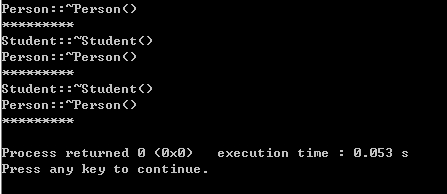浅谈多态基类析构函数声明为虚函数
Posted sole_cc
tags:
篇首语:本文由小常识网(cha138.com)小编为大家整理,主要介绍了浅谈多态基类析构函数声明为虚函数相关的知识,希望对你有一定的参考价值。
为什么基类的析构函数需要声明为virtual??
主要内容:
1、C++类继承中的构造函数和析构函数
2、C++多态性中的静态绑定和动态绑定
3、C++多态性中析构函数声明为虚函数
1、C++类继承中的构造函数和析构函数
在C++的类继承中,
建立对象时,首先调用基类的构造函数,然后在调用下一个派生类的构造函数,依次类推;
析构对象时,其顺序正好与构造相反;
具体参考文章:http://www.cnblogs.com/AndyJee/p/4575385.html
2、C++多态性中的静态绑定和动态绑定
对象的静态类型:对象在声明是采用的类型,在编译期确定;
对象的动态类型:当前对象所指的类型,在运行期决定,对象的动态类型可以更改,但静态类型无法更改。
静态绑定:绑定的是对象的静态类型,某特性(比如函数)依赖于对象的静态类型,发生在编译期。
动态绑定:绑定的是对象的动态类型,某特性(比如函数)依赖于对象的动态类型,发生在运行期。
具体参考文章:http://www.cnblogs.com/AndyJee/p/4575670.html
3、C++多态性中基类析构函数声明为虚函数
先来看几段程序例子:
- 将基类析构函数声明为虚函数
| 1 2 3 4 5 6 7 8 9 10 11 12 13 14 15 16 17 18 19 20 21 22 23 24 25 26 27 28 29 30 31 32 33 34 35 |
|
运行结果:

- 不将基类析构函数声明为虚函数:
| 1 2 3 4 5 6 7 8 9 10 11 12 13 14 15 16 17 18 19 20 21 22 23 24 25 26 27 28 29 30 31 32 33 34 35 |
|
运行结果:

可以看出:
在用基类指针指向派生类时,
在基类析构函数声明为virtual的时候,delete基类指针,会先调用派生类的析构函数,再调用基类的析构函数。
在基类析构函数没有声明为virtual的时候,delete基类指针,只会调用基类的析构函数,而不会调用派生类的析构函数,这样会造成销毁对象的不完全。
分析:
Person *pt2 = new Student;
pt2的静态类型为Person,而动态类型为Student,
当析构函数为虚函数时,为动态绑定,delete pt2,会调用动态类型即派生类的析构函数,由于继承关系,也会调用基类的析构函数;
而当析构函数为非虚函数时,为静态绑定,delete pt2,会调用静态类型即基类的析构函数,而不会调用派生类的析构函数。
(以上纯属个人理解)
总结:
-
应该为多态基类声明虚析构器。一旦一个类包含虚函数,它就应该包含一个虚析构器,因为多态性,必定会有基类调用派生类。
-
如果一个类不用作基类或者不需具有多态性,便不应该为它声明虚析构器。
转自:
https://www.cnblogs.com/AndyJee/p/4575810.html
以上是关于浅谈多态基类析构函数声明为虚函数的主要内容,如果未能解决你的问题,请参考以下文章